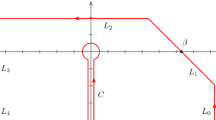Abstract
It is known that the Riemann zeta function ζ (s) in the critical strip 0 < Re(s) < 1, may be represented as the Mellin transform of a certain function φ (x) which is related to one of the theta functions. The function φ (x) satisfies a well known functional equation, and guided by this property we deduce a family of approximating functions involving an arbitrary parameter α. The approximating function corresponding to the value of α = 2 gives rise to a particularly accurate numerical approximation to the function φ (x). Another approximation to φ (x), which is based upon the first one, is obtained by solving a certain differential equation. Yet another approximating function may be determined as a simple extension of the first. All three approximations, when used in conjunction with the Mellin transform expression for ζ (s) in the critical strip, give rise to an explicit expression from which it is clear that Re(s) = 1/2 is a necessary and sufficient condition for the vanishing of the imaginary part of the integral, the real part of which is non-zero. Accordingly, the analogy with the Riemann hypothesis is only partial, but nevertheless Re(s) = 1/2 emerges from the analysis in a fairly explicit manner. While it is generally known that the imaginary part of the Mellin transform must vanish along Re(s) = 1/2, the major contribution of this paper is the presentation of the actual calculation for three functions which approximate φ (x). The explicit nature of these calculation details may facilitate progress towards the corresponding calculation for the actual φ (x), which may be necessary in a resolution of the Riemann hypothesis.
Similar content being viewed by others
References
J.B. Conrey, The Riemann Hypothesis, Notices of the AMS, 50 (2003), 341–353.
H.M. Edwards, Riemann’s Zeta Function, Academic Press, New York, 1974.
A. Erdélyi, W. Magnus, F. Oberhettinger, and F.G. Tricomi, Higher Transcendental Functions, McGraw-Hill, New York, 1953.
I.S. Gradshteyn and I.M. Ryzhik, Tables of Integrals, Series and Products, Academic Press, New York, 1965.
F. Oberhettinger and L. Badii, Tables of Laplace Transforms, Springer-Verlag, New York, 1973.
H. Rademacher, Topics in Analytic Number Theory, Springer-Verlag, Berlin, 1973.
E.C. Titchmarsh, The Theory of the Riemann Zeta-function, 2nd Edition revised by D.R. Heath-Brown, Oxford Science Publications, Clarendon Press, Oxford, 1986.
E.T. Whittaker and G.N. Watson, A Course of Modern Analysis, 4th Edition, Cambridge University Press, 1963.
Author information
Authors and Affiliations
Corresponding author
Additional information
2000 Mathematics Subject Classification: Primary—11M06, 11M26
Rights and permissions
About this article
Cite this article
Hill, J.M. Curve Fitting, Differential Equations And The Riemann Hypothesis. Ramanujan J 9, 357–372 (2005). https://doi.org/10.1007/s11139-005-1873-6
Received:
Accepted:
Issue Date:
DOI: https://doi.org/10.1007/s11139-005-1873-6




